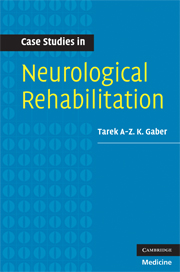Book contents
- Frontmatter
- Contents
- Preface
- Part I Clinical rehabilitation
- Part II Case studies
- 3 Medical issues in brain injury rehabilitation
- 4 Progressive neurological disorders
- 5 Medical complications of immobility
- 6 Orthotics in neurological rehabilitation
- 7 Ethical and medicolegal controversies
- 8 Chronic pain
- 9 Medically unexplained disorders
- 10 Spasticity management
- 11 Ventilatory support in rehabilitation
- 12 Sphincteric dysfunction
- 13 Communication disabilities
- 14 Sensory disability
- 15 Prescriptions for independence
- Part III Exercises in neurological rehabilitation
- Index
6 - Orthotics in neurological rehabilitation
from Part II - Case studies
Published online by Cambridge University Press: 13 August 2009
- Frontmatter
- Contents
- Preface
- Part I Clinical rehabilitation
- Part II Case studies
- 3 Medical issues in brain injury rehabilitation
- 4 Progressive neurological disorders
- 5 Medical complications of immobility
- 6 Orthotics in neurological rehabilitation
- 7 Ethical and medicolegal controversies
- 8 Chronic pain
- 9 Medically unexplained disorders
- 10 Spasticity management
- 11 Ventilatory support in rehabilitation
- 12 Sphincteric dysfunction
- 13 Communication disabilities
- 14 Sensory disability
- 15 Prescriptions for independence
- Part III Exercises in neurological rehabilitation
- Index
Summary
An orthotist once told me that there are thousands of types of ankle–foot orthoses (AFOs) and that he finds it difficult to keep up with all the changes taking place within his speciality. That was reassuring, as I always feel that it is unreasonable to expect rehabilitation clinicians, whether they are physicians or therapists, to be able to prescribe or even suggest the best orthotic management plan for their patients. However, I feel that it is extremely important to understand the basics of biomechanics and gait analysis to be able to assess and manage neurologically impaired patients properly. This will not only facilitate the clinical decision making when dealing with issues such as medical or surgical interventions for lower limb spasticity but can also help the treating clinician in deciding which patient will benefit most from an orthotic opinion.
If orthotists welcome referrals detailing the clinical situation, leaving the ultimate decision to the orthotist to decide the appropriate intervention, gait analysis laboratories do not. Some clinicians refer their patients for gait analysis expecting the report to provide the answers or explanation for the patient's gait impairment plus a recommendation of the appropriate management plan. This is rarely the case, as gait analysis is most valuable in establishing or refuting a particular hypothesis. It always helps when the referring clinician is able to formulate a hypothesis and then ask if the gait analysis can confirm or reject it.
- Type
- Chapter
- Information
- Case Studies in Neurological Rehabilitation , pp. 70 - 81Publisher: Cambridge University PressPrint publication year: 2008



